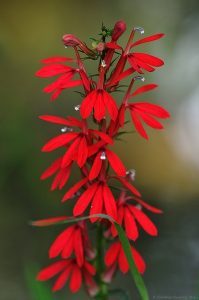Cardinal Flower
By Pat Dickey, Fairfax Master Gardener
 While many other flowering plants fade under the blistering sun of our summers, there is one that continues to brighten rain gardens, stream banks and other moist areas with its vivid red color. A native perennial forb, Lobelia cardinalis, better known as cardinal flower, blooms from July to September. This is just at the time when the hummingbirds need its nectar before their long migration home to Mexico and Central America.
While many other flowering plants fade under the blistering sun of our summers, there is one that continues to brighten rain gardens, stream banks and other moist areas with its vivid red color. A native perennial forb, Lobelia cardinalis, better known as cardinal flower, blooms from July to September. This is just at the time when the hummingbirds need its nectar before their long migration home to Mexico and Central America.
Cardinal flower is found growing in Zones 3-9, from Quebec and Minnesota, south to Florida and Texas, including Mexico and Central America. It is a member of the Family Campanulaceae, the Bellflower family. The genus name is in honor of Matthias de l’Obel, a French physician and botanist (1538-1616). The species, cardinalis, describes the bright red color of robes worn by Roman Catholic cardinals.
 Lobelia cardinalis enjoys shady or partially shady areas with moist, rich soil. Full sun exposure is okay if the area is always wet or frequently watered. Choose an area with morning sun and afternoon shade. This plant grows to three feet tall and has erect, terminal spikes of large red racemes. These flowers are tubular with three spreading lower petals and two upper petals that are all combined into a tube at the base. The dark green leaves of the species are finely toothed along the edge and are lanceolate or narrow oval-shaped tapering to a point at the ends.
Lobelia cardinalis enjoys shady or partially shady areas with moist, rich soil. Full sun exposure is okay if the area is always wet or frequently watered. Choose an area with morning sun and afternoon shade. This plant grows to three feet tall and has erect, terminal spikes of large red racemes. These flowers are tubular with three spreading lower petals and two upper petals that are all combined into a tube at the base. The dark green leaves of the species are finely toothed along the edge and are lanceolate or narrow oval-shaped tapering to a point at the ends.
Select cardinal flower for use in pollinator gardens and hummingbird gardens. It is an excellent nectar plant and attracts large bees and swallowtail butterflies, as well as hummingbirds.
After the plant has finished flowering, the basal rosette dies back but creates three or more offsets. These offsets become larger each year. Cardinal flower will overwinter, but its basal or lower foliage cannot be covered with leaves or heavy wood mulch. Use a lighter straw mulch or tuck the mulch under the leaves. The evergreen basal rosettes need to be exposed to light to photosynthesize, or the plant will starve.

‘Queen VIctoria’
All parts of the cardinal flower contain alkaloids and are toxic if ingested. Slugs and snails may damage the leaves, but there are no other disease problems. Deer and rabbits will bother young plants.
There are a few cultivars available. ‘Fried Green Tomatoes’ has maroon leaves that age to olive green and bronze. ‘Black Truffle’ has purplish black foliage, and ‘New Moon Maroon’ has reddish purple leaves. Lobelia cardinalis is a parent of the hybrid ‘Queen Victoria.’ It has dark red leaves and is adapted to live longer in gardens.
References
Cardinal Flower, Home and Garden Information Center, University of Maryland Extension
Lobelia cardinalis, Missouri Botanical Garden
Lobelia cardinalis, Lady Bird Johnson Wildflower Center, University of Texas at Austin
Cardinal Flower, Lobelia cardinalis, University of Wisconsin Extension
… updated 2023